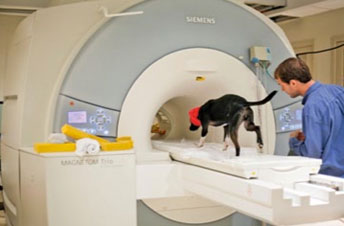Emory/CPT Expand Canine Neuroscience Project fMRI Team
May 11, 2012
On May 11, 2012, Dr. Greg Berns, MD, PhD and Andrew Brooks, PhD candidate, from Emory University’s Neuroscience Department and Mark Spivak, a project consultant from CPT, co-authored a groundbreaking research paper published in the prestigious academic journal PLoS One, entitled Functional MRI in Awake Unrestrained Dogs. The journal article details the first neuroscientific study worldwide that incorporates quality fMRI images in dogs scanned without the use of sedation or restraints.
The groundbreaking methodological advancements achieved by the Emory/CPT team received significant media coverage, including from ABC World New Tonight, ABC News.go.com, the LA Times, Time.com, Rolling Stone.com, Scientific American.com, and Psychology Today. The article about the team was the number one downloaded article on Time.com for a period of 3 weeks. A press release from Emory University was covered by many major and minor media outlets and a YouTube video about the project has received close to 160,000 hits.
In May 2011, Emory and CPT began collaborating on a humane approach to use functional magnetic resonance imaging (fMRI) to better acquire knowledge related to the human-animal bond, canine cognition, canine emotions, canine sensory perception, and canine receptive communication.

Researcher Andrew Brooks observes Callie enter the Emory fMRI machine.
The Emory/CPT team’s first study, which measured differences in brain caudate responses to two human hand-signal communications, one that meant a reward was forthcoming and the other which meant that no reward was forthcoming. The caudate, especially the nucleus accumbens/ventral striatum and to a lesser degree the left amygdala, activate with dopamine and serotonin respectively when there is anticipation of a reward, the expectation of pleasure, or the receipt of pleasure. The study demonstrated that the dogs learned to cognitively and emotionally differentiate the relevance of the two communication signals, as indicated by the significant difference in brain activation dependent upon the particular signal. Moreover, using the humane approach designed by the team, the scan images were very clear. Thus, the team was able to prove to the worldwide neuroscientific community that humane approaches are viable when using fMRI as a tool to study animal cognition.
The research team has since completed a second study, not yet published, that evaluates the dogs’ emotional response to a variety of canine and human social scents. Planned future research will study canine vision, canine learning, and canine emotions for applications that the group hopes will improve the quality of training protocols for both pet and working purposes.
Initially, the team trained two subject dogs to become the first dogs worldwide to remain relatively motionless in an fMRI scanner while awake and unrestrained. For the researchers to obtain quality brain images, the dogs can not move more than 3 mmm in any spatial plane for a period 12 to 25 seconds and must do so in a confined space designed for the human anatomy and amidst high-pitched, high-volume sound that may reach 110 dB.
Now that the Emory/CPT team has proven the viability of its unique humane research methodology, they realize that the next step is to expand the size of its fMRI dog team, so that the group can produce a higher volume of methodologically sound research from a larger sample base of subject animals. Thus, on July 29, 2012 the team held open tryouts. The tryouts evaluated the candidate dogs’ socialization, obedience, and temperament to determine whether they have the background and mettle to become part of an enlarged fMRI dog team that the researchers believe in the upcoming years will provide major insight into how dogs sense the environment, think, emote, and learn.
The tryouts were very successful as 8 dogs met the criteria to be included on the team, which now enlarges the team from 2 dogs to 10 dogs. Mark Spivak, President of CPT and one of the team leaders stated, “We plan to further expand to a team of 30 trained dogs by no later than the first quarter of 2013.”
According to Mr. Spivak, “Dogs have co-evolved with humans over the last 14,000 years, whereby they play an integral role in the lives of many persons and organizations. Dogs uniquely provide value as household companions and pets, as service animals for the disabled, as adjunct law enforcement officers that detect contraband, locate cadavers, and apprehend miscreants, as volunteers that track and locate missing children, and as vital military soldiers that perform sentry duties and locate explosives better than any mechanical spectrometer. We believe that our research will further the human-animal bond, help humans to better understand their dogs, and enable persons and organizations to better train their dogs, regardless of whether the dogs are family pets or serious working animals. Most importantly, we believe our research will ultimately lead to a higher quality of life for dogs and a higher quality of life for the humans that accompany their pet and working dogs.”
For more information about the Emory/CPT Neuroscience Project, please review the links contained in this article or contact Mark Spivak at CPT by email (MarkCPT@aol.com) or by phone (404-236-2150).


